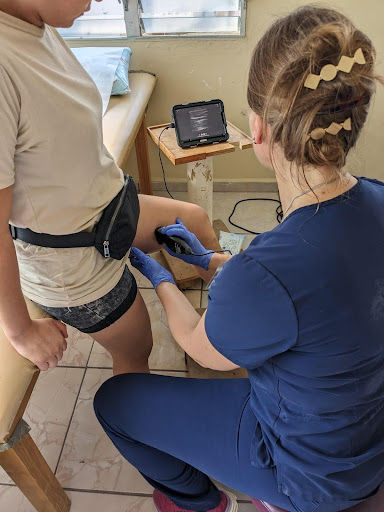I recently returned from my ninth mission trip to Honduras to provide varicose treatments and vein care for patients who would otherwise go untreated. This past March, I traveled once again to Tela, Honduras, where our dedicated team from the Hackett Hemwall Patterson Foundation (HHPF) worked tirelessly to help as many people as possible. This year, we reached an incredible milestone—our team saw 817 patients in one incredibly busy week.
This mission trip to Honduras to treat ulcers, chronic wounds, and varicose veins is always a powerful reminder of why I became a physician. The need is overwhelming, the conditions are challenging, and the work is exhausting—but the impact is life-changing, both for the patients and for me.
Why We Go
Since 2003, the HHPF has been sending medical teams to Honduras for medical mission trips to provide care for chronic wounds, ulcers, and chronic venous disease. Many of the patients we treat suffer from painful swelling, skin changes, and ulcers due to untreated vein disease. In the U.S., these conditions are manageable with modern medical treatments, but for people in underserved areas, access to specialized vein care is nearly impossible.
I feel incredibly fortunate to be able to use my skills to make a difference—even if it’s just for one week a year. This mission is about more than treating symptoms—it’s about restoring mobility, dignity, and hope.
A Week of Intense, Rewarding Work
Our clinic in Tela is set up in a local church, where we transform Sunday School rooms into makeshift treatment areas. There’s minimal air conditioning, limited supplies, and long lines of waiting patients. But none of that matters when we see the gratitude in our patients’ eyes.
Many people travel for hours—or even days—to reach us. Some come from remote villages in the cloud forests, while others cross borders from Guatemala and Belize. They arrive on foot, by horseback, by cart, or in overcrowded buses, often sleeping on the beach or in the streets just to hold their place in line.
This year, I saw an especially high number of patients with chronic wounds. Many had ulcers wrapped in whatever materials they could find for makeshift bandages. Some had been living with these open wounds for years, unable to find relief. Treating these cases became a major focus for me, as proper wound care is essential for preventing infections, reducing pain, and helping patients regain their quality of life.
The Power of Collaboration
One of the most impactful aspects of this mission trip to Honduras for ulcer, chronic wound, and varicose vein treatments is the collaboration between various organizations and volunteers. We work closely with Honduran volunteers to ensure the success of the trip. They help spread the word about our clinic, organize and triage patients, and provide a point of contact for follow-up care.
Our Honduran colleagues work tirelessly—not just during the week we’re there, but in the months leading up to and following the clinic. Their efforts make it possible for us to serve as many patients as possible in a very short period of time.
A Family Commitment to Service
This year’s trip was especially meaningful because my two oldest children joined me in Tela, working as clinician’s assistants. They jumped right into the fast-paced environment—helping prep patients, fetch medicines and supplies, and keep the clinic running smoothly.
It was incredible to watch them immerse themselves in the work, seeing firsthand the challenges and rewards of medical service. They worked long hours alongside our team, experiencing both the exhaustion and the deep fulfillment that comes from helping those in need. Having them there made this mission even more special, and I hope it inspires them to continue finding ways to serve others in the future.
Moments That Stay With Me
One of the most rewarding aspects of these trips is seeing returning patients from previous years. This time, several patients came back to show me how their ulcers had completely healed since their last treatment. It’s hard to put into words how much that means to me. It’s proof that what we do here isn’t just a temporary fix—it’s real, lasting change in people’s lives.
There are always heartbreaking moments, too. We can’t help everyone, and we often have to make difficult decisions about which patients to treat in the short time we have. But we do our best, knowing that for many, this one opportunity for care could make all the difference.
Looking Ahead
As I reflect on this year’s mission trip to Honduras to help with chronic wounds and varicose vein treatments, I feel deeply grateful for the opportunity to serve. This work is humbling and reminds me why being a physician is such an important part of my life. I’m already looking forward to returning next year and remain committed to finding ways to expand access to vein and wound care—not just in my clinic, but in underserved communities around the world.

